

Getting Real about Health Care Costs — A Broader Approach to Cost Stewardship in Medical Education. Integrating Economics Into Medical Training. In medical school, students spend a lot of time thinking about how to communicate with patients and incorporate shared decision-making into their treatment.

The American Medical Association (AMA) believes it is time that finance becomes part of that crucial conversation. The AMA recently adopted a new policy calling on medical schools and residency programs to include content related to healthcare economics. Under the health economics umbrella, the AMA recommends training on topics like modes of practice, cost-effective treatments and testing, practice management, and the economics of practices in various financing systems. Wise use of limited resources Susan Skochelak, MD, AMA’s Group Vice President for Medical Education, said physicians can no longer separate clinical care and economics.
“Doctors are not paying attention to things that would make a huge difference to patients,” Dr Skochelak said. Creating a curriculum Making smart choices. A five-step program for diagnostic test addiction. Why Do Doctors Overtreat? For Many, It's What They're Trained To Do. Updates From The Field - February 2018. Within the “Room of Horrors”’—usually a spare inpatient room—lies a hospital bed, a dummy patient and an assortment of artificial patient information.
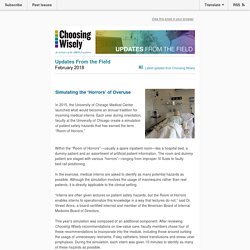
The room and dummy patient are staged with various “horrors”—ranging from improper IV fluids to faulty bed-rail positioning. In the exercise, medical interns are asked to identify as many potential hazards as possible. Although the simulation involves the usage of mannequins rather than real patients, it is directly applicable to the clinical setting.
“Interns are often given lectures on patient safety hazards, but the Room of Horrors enables interns to operationalize this knowledge in a way that lectures do not,” said Dr. Vineet Arora, a board-certified internist and member of the American Board of Internal Medicine Board of Directors. This year’s simulation was composed of an additional component. “Interns seemed to have a more difficult time identifying low-value hazards compared to patient safety hazards,” said Dr. Dr. Choosing Wisely: Resource Stewardship in Canadian Medical Schools. Why do residents order unnecessary labs? Published in the March 2017 issue of Today’s Hospitalist ALL INPATIENTS should routinely have a daily CBC and basic chemistry screen, right?
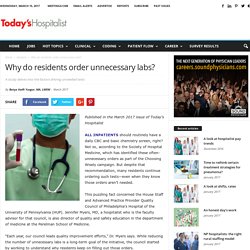
Not so, according to the Society of Hospital Medicine, which has identified these often-unnecessary orders as part of the Choosing Wisely campaign. But despite that recommendation, many residents continue ordering such tests—even when they know those orders aren’t needed. This puzzling fact concerned the House Staff and Advanced Practice Provider Quality Council of Philadelphia’s Hospital of the University of Pennsylvania (HUP). Jennifer Myers, MD, a hospitalist who is the faculty advisor for that council, is also director of quality and safety education in the department of medicine at the Perelman School of Medicine.
“Each year, our council leads quality improvement efforts,” Dr. Tracking Resident Orders to See If They’re Reducing Unnecessary Tests. Does showing residents the number of hospital tests they order in comparison to their peers encourage them to order more appropriately?
Physicians in the Department of Medicine will find out, thanks to a soon-to-be-launched dashboard that uses Epic data to track the number of tests residents order for patients. The dashboard focuses on residents because they manage most hospitalized Department of Medicine patients, but it could one day be broadened to include faculty members. “There’s no way to change behavior if you don’t know what your behavior is,” says Lenny Feldman, an internist who helped create the dashboard with fellow internist Amit Pahwa and the Johns Hopkins Technology Innovation Center.
The Buffy Care dashboard (named after Buffy the Vampire Slayer) focuses on tracking blood tests and imaging, like CT and MRI scans. Assessing Correlations of Physicians' Practice Intensity and Certainty During Residency Training. Spending patterns in region of residency training and subsequent expenditures for care provided by practicing physicians for Medicare beneficiaries. Role-Modeling Cost-Conscious Care—A National Evaluation of Perceptions of Faculty at Teaching Hospitals in the United States. The Association Between Residency Training and Internists’ Ability to Practice Conservatively. Tolerating Uncertainty - The Next Medical Revolution? Choosing Wisely®: Things we do for no reason - Feldman - 2015 - Journal of Hospital Medicine. Test ordering by GP trainees. Physician Understanding and Ability to Communicate Harms and Benefits of Common Medical Treatments. From Choosing Wisely to Practicing Value—More to the Story.
High-Value Testing Begins With a Few Simple Questions. Terms of Use The In the Clinic® slide sets are owned and copyrighted by the American College of Physicians (ACP).
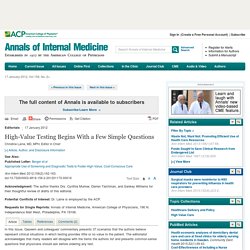
All text, graphics, trademarks, and other intellectual property incorporated into the slide sets remain the sole and exclusive property of the ACP. The slide sets may be used only by the person who downloads or purchases them and only for the purpose of presenting them during not-for-profit educational activities. Users may incorporate the entire slide set or selected individual slides into their own teaching presentations but may not alter the content of the slides in any way or remove the ACP copyright notice. Providing High-Value, Cost-Conscious Care: A Critical Seventh General Competency for Physicians. Terms of Use The In the Clinic® slide sets are owned and copyrighted by the American College of Physicians (ACP).
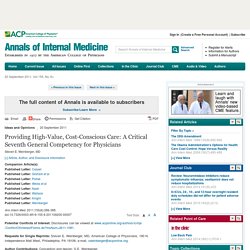
All text, graphics, trademarks, and other intellectual property incorporated into the slide sets remain the sole and exclusive property of the ACP. The slide sets may be used only by the person who downloads or purchases them and only for the purpose of presenting them during not-for-profit educational activities. Users may incorporate the entire slide set or selected individual slides into their own teaching presentations but may not alter the content of the slides in any way or remove the ACP copyright notice. Residents' self-report on why they order perceived unnecessary inpatient laboratory tests - Sedrak - 2016 - Journal of Hospital Medicine. Teaching high-value care: a novel morning report - Bowman - 2015 - The Clinical Teacher. Teaching high-value, cost-conscious care to residents: the Alliance for Academic Internal Medicine–American College of Physicians Curriculum.
Medicine’s Push for Resource Stewardship in Education and Practice. Scare: stewardship curriculum and audit for residents to cultivate efficiency. A New Model for Medical EducationCelebrating RestraintA New Model for Medical Education. Health care expenditures are a major concern of governments in Canada and the United States.

Over the past 40 years, a variety of approaches have been used to control costs, including global budgeting, managed competition, cost sharing, and pay for performance. Policy makers recognize that physicians play a central role, with some estimates suggesting that physicians control 80% of health expenditures.1. Training Physicians to Provide High-Value, Cost-Conscious Care: A Systematic Review. Importance Increasing health care expenditures are taxing the sustainability of the health care system.
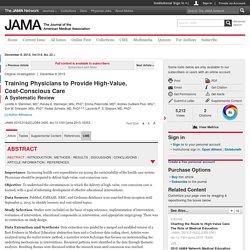
Teach trainees more thought, less waste. From the March ACP Hospitalist, copyright © 2015 by the American College of Physicians By Julie Knudson Teaching students and residents to practice high-value care requires a significant shift from traditional training methods.
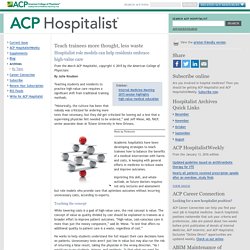
“Historically, the culture has been that nobody was criticized for ordering more tests than necessary, but they did get criticized for leaving out a test that a supervising physician felt needed to be ordered,” said Jeff Wiese, MD, FACP, senior associate dean at Tulane University in New Orleans. Photo by Thinkstock Academic hospitalists have been developing strategies to teach trainees how to balance the benefits of a medical intervention with harms and costs, in keeping with general efforts in medicine to reduce waste and improve outcomes. Imprinting this skill, and whole outlook, on future doctors requires not only lectures and assessment but role models who provide care that optimizes outcomes without incurring unnecessary costs, according to experts. Top. Test ordering for preventive health care among family medicine residents. Daisy Fung, MD Inge Schabort, MB ChB Catherine A.
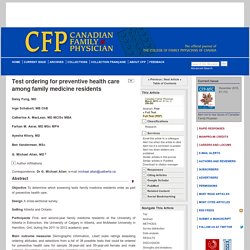
Test ordering for preventive health care among family medicine residents. Objective To determine which screening tests family medicine residents order as part of preventive health care. Design A cross-sectional survey. Promoting Patient-Centered Counseling to Reduce Use of Low-Value Diagnostic Tests: A Randomized Clinical Trial. Importance Low-value diagnostic tests have been included on primary care specialty societies’ “Choosing Wisely” Top Five lists. Training the Next Generation of Doctors in Palliative Care I...